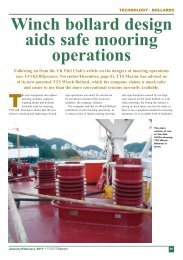Create successful ePaper yourself
Turn your PDF publications into a flip-book with our unique Google optimized e-Paper software.
12 <strong>TTS</strong> <strong>Review</strong> June <strong>2003</strong><br />
<strong>TTS</strong> Ships Equipment’s IPSI<br />
and INTEGRATION projects lead to designs<br />
for enhanced ro-ro cargo handling operations<br />
Gothenburg-based <strong>TTS</strong> Ships Equipment AB,<br />
the ro-ro access equipment ‘Centre of<br />
Excellence’ within the <strong>TTS</strong> Marine group of<br />
companies, has been a pioneer in the<br />
development of new cargo handling systems<br />
for ro-ro vessels over the years.<br />
The company has been heavily involved in two EUsponsored<br />
projects, IPSI (Improved Port Ship Interface)<br />
and INTEGRATION, both designed to provide Europe<br />
with economic short sea ro-ro door-to-door operations.<br />
IPSI, which ran between 1996 and 1999, was a<br />
revolutionary feasibility project in intermodal transport designed<br />
to ease traffic congestion and improve safety on the roads of Europe<br />
by moving freight onto ships or inland waterways craft.<strong>TTS</strong> Ships<br />
Equipment led the consortium developing this project.The follow-up<br />
project, INTEGRATION, takes all of the lessons learned from IPSI<br />
and integrates them into a ‘real demonstration’ project to develop an<br />
economic door-to-door short sea shipping service utilising the ro-ro<br />
concept.This means developing new ro-ro designs, cargo handling<br />
systems and integrated ship-shore techniques.<br />
In INTEGRATION,<strong>TTS</strong> Ships Equipment has been tasked with<br />
demonstrating cargo handling systems to enhance efficient<br />
port/terminal operations. Both projects involve:<br />
• Developing new concepts for flexible and efficient interfaces<br />
between land and waterborne means of transport<br />
• Developing methods and equipment for the effective transfer<br />
of cargo and information about cargo with the focus on high<br />
efficiency and low investment<br />
• Demonstrating the port/ship interface concept to verify the<br />
effectiveness of intermodal cargo exchange in a ‘door-todoor’<br />
context<br />
The latest innovation from these programmes is a new design of<br />
ro-ro trailer trestle with built in cargo lashing system.The IPSI Trailer<br />
Trestles offer both ship owner and port operators major advances in<br />
reducing vessel turnaround times, improved safety and important<br />
savings in the manpower requirements for handling a ro-ro equipped<br />
with these trestles.<br />
Several prototypes of the new trestle have been produced and<br />
tested in full scale operation aboard a number of freight ro-ros in<br />
service in Northern Europe.The trestle has been type approved by<br />
DNV in 2002 for a 36 ton trailer with a maximum of 20 tons on the<br />
king-pin.<br />
Why is this development so important? When handling trailers in<br />
short sea ro-ro operations, the trestle is a major component in the<br />
cargo securing system. By using the IPSI Trailer Trestle, the number<br />
of securing points is significantly reduced, and in certain<br />
circumstances even removed, without impacting on the safety of the<br />
cargo, crew or ship.<br />
The manpower required for conventional lashing of trailers on a<br />
typical North Sea freight ro-ro is 32, however utilising the IPSI Trailer<br />
Trestle system this figure is significantly reduced to just 10! With the<br />
high cost of port workers in Northern Europe and seamen, the<br />
financial savings are considerable.<br />
The IPSI Trailer Trestle is of steel construction with a built-in<br />
standard ‘fifth wheel’ on top of a standard 2-inch king-pin underneath.<br />
In each leg the web lashing is stowed and in the foot a specially<br />
designed rubber pad is fitted, to obtain the highest possible friction<br />
against the ship’s deck.<br />
The Swedish Maritime Institute has recently approved the new<br />
trestle and wheel-end design for use with reduced lashing onboard<br />
the ro-ro Stena Freighter, which operates on the route between<br />
Gothenburg (Sweden) and Kiel (Germany).<br />
With its extensive experience in the design of modern ro-ro<br />
vessels and cargo handling equipment,<strong>TTS</strong> Ships Equipment is<br />
helping Europe lead the way in economic short-sea ro-ro door-to-door<br />
operations.


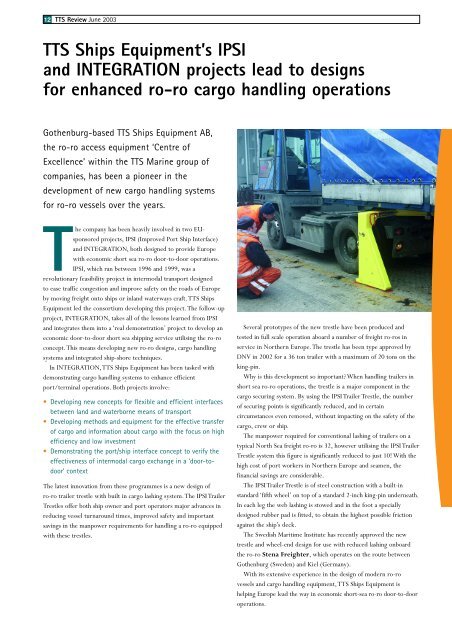


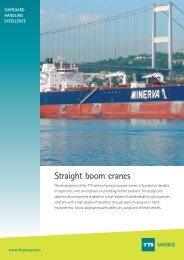
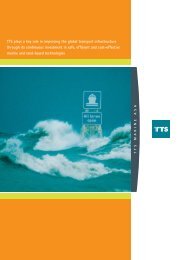
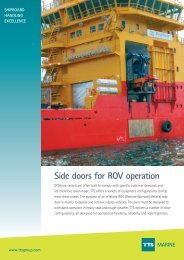
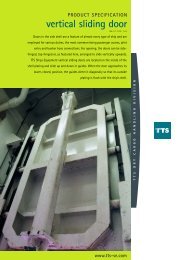
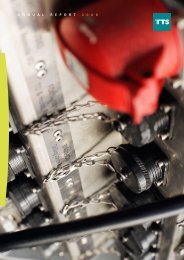
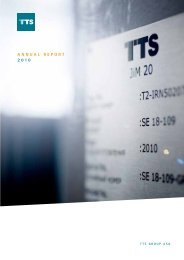
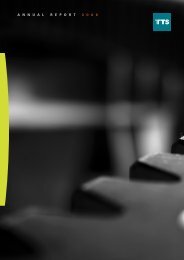
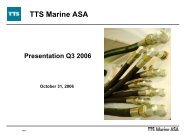
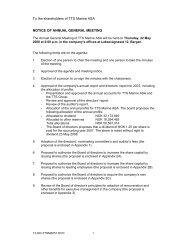
![2012.MasterPresentation_final [Compatibility Mode] - TTS Group ASA](https://img.yumpu.com/4612021/1/190x146/2012masterpresentation-final-compatibility-mode-tts-group-asa.jpg?quality=85)

